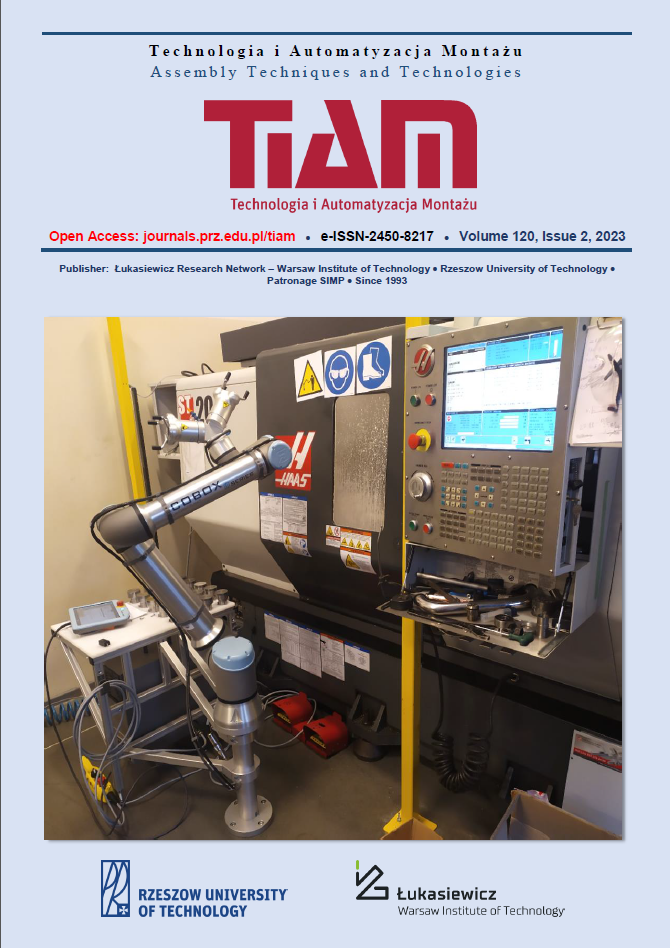Abstract
The article presents the concept and structure of a prototype of a vending machine that can dispense disposable personal protection equipment (PPE) or other products with similar physical properties (size, weight) to be used in outpatient clinics, hospitals or beauty parlours, where special and effective protection against pathogens is required, particularly during the pandemic. Due to the difficult-to-predict and unspecified technical and on-site conditions for the installation and use of the device, the authors wanted to achieve autonomy by using a replaceable battery as a power source and large storage capacity of a product rack, at a limited size of the device. The machine operates on a contactless payment system (credit/debit card or NFC mobile payments) – to buy a gown, a customer just has to tap or wave their card on or over the card reader installed in the front wall of the cabinet. Purchased products are dispensed automatically, once the transaction has been approved. The vending machine is also equipped with a removable dispenser to better manage any waste generated. The prototype was comprehensively tested in accordance with the developed verification methodology, in cooperation with an entity interested in implementing the device.
This is an Open Access article distributed under the terms of the Creative Commons Attribution License CC BY 4.0 (https://creativecommons.org/licenses/by/4.0/)
References
Buffington A. M. 2017. Are Vending Machine Selections Healthier? Trends in Dietary Quality of Vending Machine Food and Beverage Selections among NHANES Participants Age 6-19 Years between 2003-2012. University of Nevada, Las Vegas.
Czajka P., Samborski T., Garbacz P., Mężyk J. 2017. Automatisation of Multi-Parametric Quality Inspection of Rotary Symmetrical Metal Elements. Journal of Machine Construction and Maintenance, (2): 35-43.
Fukuda K., Iwako T., Nakajima N. 2015. Product Dispensing Mechanism for Vending Machines for Global Market. Fuji Electric Review Vol.61-No.3: 187-190.
Garbacz P., Czajka P., Mizak W. 2016. Automation of Residual Stress Measurement in Tableware Glass Production. Problemy Eksploatacji – Maintenance Problems, (1): 29–40.
Jaskulski A. 2020. Autodesk Inventor Professional. Helion.
Kajimura T., Kametani N., Miyagishi T. 2003. Present Status and Future Prospects of Vending Machines. Fuji Electric Review Vol.49-No.1: 2-6.
Kobayashi T., Nishi M., Tamura T. 2003. Multi-purpose Food Vending Machines. Fuji Electric Review Vol.49-No.1: 11-15.
Kozioł S., Samborski T., Zbrowski A., Lipiński J. 2018. Modułowa struktura robota malarskiego do malowania obrazów. Technologia i automatyzacja montażu, (4): 21-27.
Kozioł S., Zbrowski A., Wiejak J. 2010. Modernisation of the technological line for the production of moisture resistant cable laminatem. Problemy Eksploatacji (4): 115-125.
Mizak W., Mazurkiewicz A., Smolik J., Zbrowski A. 2014. Problems with abrasive dosing in erosive wear process modelling. Eksploatacja i Niezawodnosc – Maintenance and Reliability (4): 559-564.
Samborski T., Zbrowski A., Mrozek M., Kozioł S. 2023. Automatic semifluid mass dispenser. Technologia i automatyzacja montażu, (1): 37-43.
Segrave K. 2015. Vending Machines: An American Social History. McFarland.
Zacharski S., Samborski T. 2015. Robotised and reconfigurable system to support the production process in the machining industry. Problemy Eksploatacji – Maintenance Problems, (1): 111-120.
Zbrowski A., Giesko T. 2008. Automatyzacja kontroli jakości wyrobów w linii technologicznej wytwarzania wałeczków łożysk tocznych. Technologia i Automatyzacja Montażu, (2): 36–40.
Zbrowski A. 2016. Metodyka badań prototypów i jednostkowych urządzeń technicznych. Radom: Wydawnictwo Naukowe ITeE – PIB.
Zgłoszenie patentowe P.443101. 2022. Urządzenie do samoobsługowej sprzedaży zwłaszcza jednorazowej odzieży ochronnej oraz sposób samoobsługowej sprzedaży zwłaszcza jednorazowej odzieży ochronnej.


